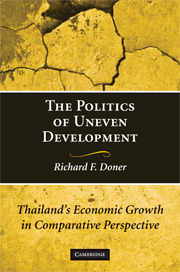Book contents
- Frontmatter
- Contents
- List of Tables and Figures
- Acknowledgments
- List of Abbreviations
- 1 The Challenge of Uneven Development
- 2 Puzzles of Thai Development in Comparative Perspective
- 3 Development Tasks, Institutions, and Politics
- 4 Origins and Consequences of Thailand's Intermediate State
- 5 Sugar
- 6 Textiles
- 7 Automobiles
- 8 Conclusion
- Appendix
- Bibliography
- Index
7 - Automobiles
Published online by Cambridge University Press: 05 June 2012
- Frontmatter
- Contents
- List of Tables and Figures
- Acknowledgments
- List of Abbreviations
- 1 The Challenge of Uneven Development
- 2 Puzzles of Thai Development in Comparative Perspective
- 3 Development Tasks, Institutions, and Politics
- 4 Origins and Consequences of Thailand's Intermediate State
- 5 Sugar
- 6 Textiles
- 7 Automobiles
- 8 Conclusion
- Appendix
- Bibliography
- Index
Summary
In 1995, Business Week identified Thailand as “Asia's New Car Capital,” and Thai leaders began describing their country as the “Detroit of Asia.” Thai automobile production had risen from around 100,000 units per year since the mid-1980s to a million units in 2005, despite a slump following the 1997 crisis (Figure 7.1). Exports, especially of the 1-ton pickup trucks for which Thailand became the second largest market in the world and a major production site for Japanese carmakers, figured as a key part of this growth (Figure 7.2). Those exports were based in part on well-developed automotive clusters housing large numbers of global producers (Figures 7.3 and 7.4). Their growth made the industry an important part of the Thai economy: by 2005 the industry accounted for 8% of the workforce and 15% of GDP, and it was the country's second largest source of export revenues.
The Thai automotive industry is, then, a clear example of successful structural change. Indonesia's auto industrialization efforts and large population (216 million vs. Thailand's 63 million in 2006) also had drawn foreign producers, but it was Thailand, not Indonesia, that became “a major base for vehicle assemblers from advanced industrial economies.” But Thailand's automotive record has been weaker than South Korea's (Figures 7.5 and 7.6). As of 2006, Korea was East Asia's only mass exporter of passenger vehicles, ranking fourth in the world in vehicle production and exporting half of its output.
- Type
- Chapter
- Information
- The Politics of Uneven DevelopmentThailand's Economic Growth in Comparative Perspective, pp. 228 - 274Publisher: Cambridge University PressPrint publication year: 2009

